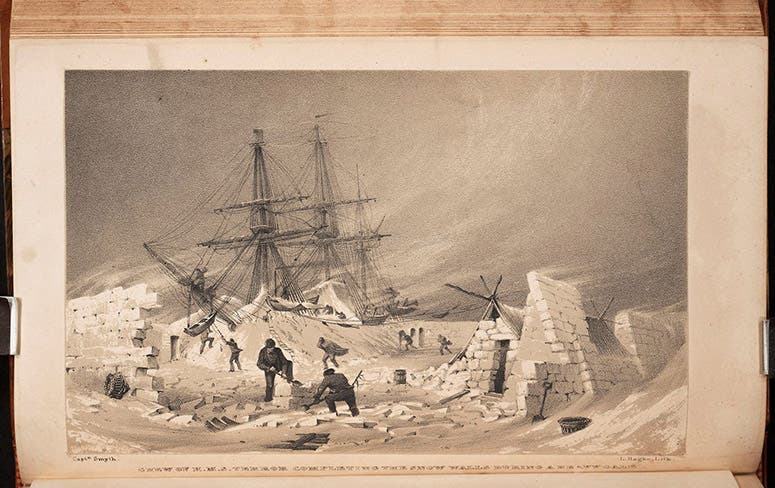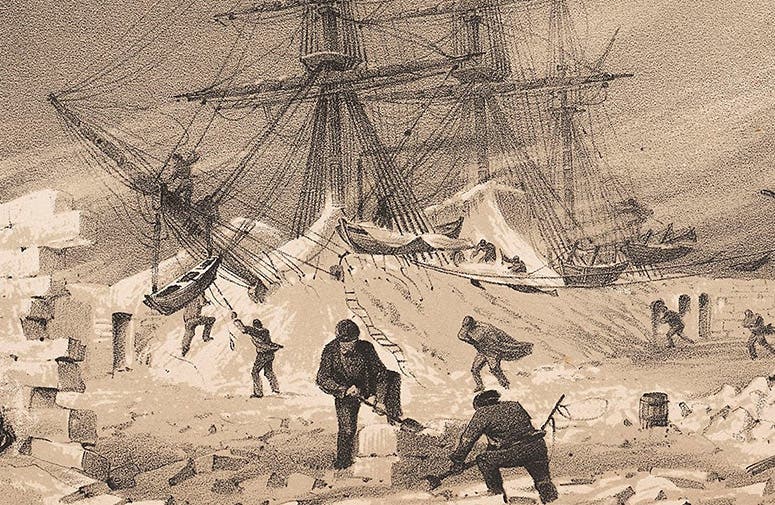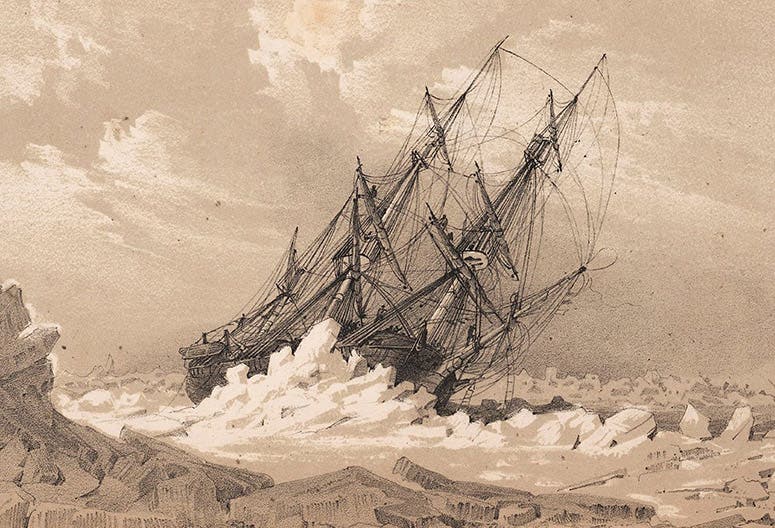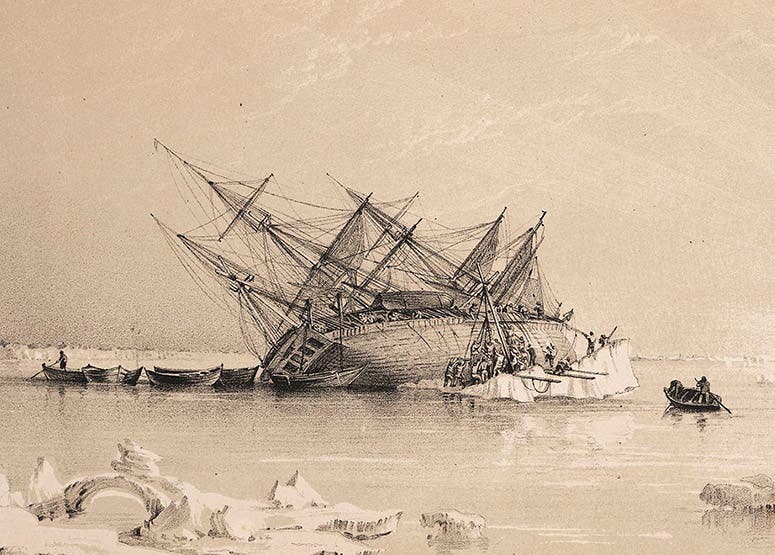Scientist of the Day - HMS Terror
![“The crew of H.M.S. Terror saving the boats and provisions on the night of 14th March [1837]”, detail of a lithograph based on a drawing by William Smyth, in Narrative of an Expedition in H.M.S. Terror … in the years 1836-7, by George Back, 1838 (Linda Hall Library)](https://assets-us-01.kc-usercontent.com:443/9dd25524-761a-000d-d79f-86a5086d4774/0d7308ca-3972-4a62-b329-9e082e98177f/Terror%201.jpg?w=775&h=588&auto=format&q=75&fit=crop)
“The crew of H.M.S. Terror saving the boats and provisions on the night of 14th March [1837]”, detail of a lithograph based on a drawing by William Smyth, in Narrative of an Expedition in H.M.S. Terror … in the years 1836-7, by George Back, 1838 (Linda Hall Library)
HMS Terror, a new kind of Royal Navy warship called a "bomb vessel," was launched June 29, 1813, at the Topsham shipyard in Devon. Bomb vessels were exceptionally strong ships, with double oak hulls, and were designed to withstand the recoil of mortar and cannon bombardment. Firing a 13-inch mortar from the deck of an ordinary warship would tear it apart. Earlier this month we wrote about another bomb vessel, HMS Erebus, which was 13 years younger than Terror, but the two were destined to be expedition mates on two famous voyages, one successful and the other an unprecedented disaster. So we thought it appropriate to give equal time to the Terror, especially since, on one particular voyage that did not include the Erebus, she generated a pictorial record that is quite spectacular, as I hope you are now discovering.

Title page, Narrative of an Expedition in H.M.S. Terror, Undertaken with a View to Geographical Discovery on the Arctic Shores, in the years 1836-7, by George Back, 1838 (Linda Hall Library)
The Terror was doing quiet duty in the Mediterranean in 1835, when second Secretary of the Admiralty John Barrow decided that bomb vessels, with their extra-strong hulls, might be just the thing for ploughing through Arctic ice in search of a Northwest passage. George Back, a young lieutenant but a veteran of three Arctic adventures, had just returned from an expedition up the Great Fish River, and Barrow wanted to send him up the Fox Channel at the top of Hudson’s Bay to see if he could find passage there to the Arctic archipelago. He put Back and a crew of 60 aboard the Terror and sent her north. You can see the features of George Back in a famous group portrait of the leaders of Arctic Exploration, 1851, by Stephen Pearce, at our post on Pearce. Back, now an Admiral, is at the far left of the first image.

“The crew of H.M.S. Terror completing the snow walls during a heavy gale,” lithograph based on a drawing by William Smyth, in Narrative of an Expedition in H.M.S. Terror … in the years 1836-7, by George Back, 1838 (Linda Hall Library)

Detail of third image, to show the lithographic texture of the print (Linda Hall Library)
The voyage of HMS Terror in 1836-37 was a total fiasco, by most measures. The ice pack in the Fox Channel was unusually thick and destructive in the winter of 1837, and the Terror never got through it. The ship was battered and crushed unrelentingly by the ice over the course of 6 months, and by the summer of 1837, she was a near total wreck, her double-thick hull stove in in numerous places. At one point she was totally on her side in the icepack, and on several occasions, the crew removed all the provisions, sure that the ship was about to sink. Yet the Terror persevered, and with the summer thaw, was able to limp back to Ireland and collapse on the shore. The mission was a failure, but the bomb vessel experiment was a success. Everyone agreed that there was no other ship in the world that could have withstood the colossal forces exerted by the ice and survived.

“Position of H.M.S. Terror on the 22nd Feby. 1837,” detail of a lithograph based on a drawing by William Smyth, in Narrative of an Expedition in H.M.S. Terror … in the years 1836-7, by George Back, 1838 (Linda Hall Library)

“H.M.S. Terror nipped in the ice in Fox’s Channel, detail of a lithograph based on a drawing by William Smyth, in Narrative of an Expedition in H.M.S. Terror … in the years 1836-7, by George Back, 1838 (Linda Hall Library)
Fortunately for us curiosity seekers, one of Back’s crewmen, William Smyth, was a gifted shipboard artist, and he made numerous drawings of the Terror in her various states of predicament, which were soon printed in Back’s Narrative of an Expedition in H.M.S. Terror (1838). In the book, the lithographs are in chronological order, with the caption usually providing the date. I have rearranged them slightly here, mostly because I wanted to lead with the night scene. I have also cropped and enlarged most of the lithographs, because this is a post about a ship, and I wanted the Terror to dominate each scene. One plate (third image) is shown full-page, so you can get an idea of how the lithographs appear in the book. For this plate we also show a close detail, so you can appreciate the unique texture that lithography provides (fourth image).

“Situation of H.M.S. Terror on the 14th July, 1837,” detail of a lithograph based on a drawing by William Smyth, in Narrative of an Expedition in H.M.S. Terror … in the years 1836-7, by George Back, 1838 (Linda Hall Library)
HMS Terror, having proved her worth as a polar vessel, was rebuilt and sent out again, this time to encounter Antarctic ice with HMS Erebus, under the command of James Clark Ross, 1839-43, a story we told in our post on HMS Erebus. Having had such success in southern seas, the two were sent out again in 1845, under the overall command of John Franklin, to locate the final gaps in the Northwest passage. The commander of the Terror on the Franklin expedition was Francis Crozier, who had commanded the Terror in Antarctica. The Erebus and Terror were last seen in 1847, and the Royal Navy and various private parties spent the next 10 years trying to find the ships, Franklin, and his crew. It was finally learned that the ships had been abandoned in the ice off King William Island in 1848, the men had trekked south to their deaths, and the Erebus and Terror drifted in the ice and ultimately sank.
![“View of the fractured stern-post of H.M.S. Terror, taken on the beach at Lough Swilly [Ireland],” detail of a lithograph based on a drawing by William Smyth, in Narrative of an Expedition in H.M.S. Terror … in the years 1836-7, by George Back, 1838 (Linda Hall Library)](https://assets-us-01.kc-usercontent.com:443/9dd25524-761a-000d-d79f-86a5086d4774/1be0502b-c642-4b99-bb6f-a7c72840bf42/Terror%208.jpg?w=390&h=600&auto=format&q=75&fit=crop)
“View of the fractured stern-post of H.M.S. Terror, taken on the beach at Lough Swilly [Ireland],” detail of a lithograph based on a drawing by William Smyth, in Narrative of an Expedition in H.M.S. Terror … in the years 1836-7, by George Back, 1838 (Linda Hall Library)
On Sep. 12, 2016, the remains of the Terror were found on the sea floor in Terror Bay, off King William Island in Nunavut. The Erebus had been found two years early, about 30 miles away. The two wreck sites have been declared a National Historic Site of Canada; the exact location of both shipwrecks is kept secret. The wreck of the Terror has been mapped by underwater teams and robotic cameras; there are imminent plans to try to penetrate the cabin of Capt. Crozier, which seems to have remained intact, in search of written records. HMS Terror may still have something to say about the Golden Age of Arctic exploration.
William B. Ashworth, Jr., Consultant for the History of Science, Linda Hall Library and Associate Professor emeritus, Department of History, University of Missouri-Kansas City. Comments or corrections are welcome; please direct to ashworthw@umkc.edu.

![“The crew of H.M.S. Terror saving the boats and provisions on the night of 14th March [1837]”, detail of a lithograph based on a drawing by William Smyth, in Narrative of an Expedition in H.M.S. Terror … in the years 1836-7, by George Back, 1838 (Linda Hall Library)](https://assets-us-01.kc-usercontent.com:443/9dd25524-761a-000d-d79f-86a5086d4774/0d7308ca-3972-4a62-b329-9e082e98177f/Terror%201.jpg?w=534&h=582&auto=format&q=75&fit=crop)




